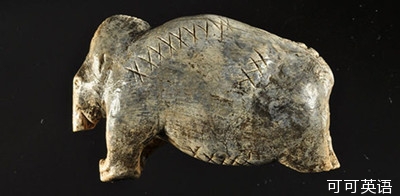They are making objects that are less about physically changing the world than about exploring the order and the patterns that they see in it. In short, they are making art. Why? Why do all modern humans share the compulsion to make works of art? Why does man the toolmaker everywhere turn into man the artist?
他們進行物品創造的目的,再也不僅僅是為了純粹的從物理上去改變周遭的世界,而更是為了去探索他們在大自然中觀察出來的眾多規律與模式。簡而言之,他們在創造藝術。為什么呢?為什么所有現代人類有這種創造藝術品的通性?為什么全球范圍內原來是工具創造者的人類變成了藝術創造者的人類?
Our two reindeer represent the oldest piece of art in any British art gallery or museum, and it's alarmingly delicate. We keep it in a climate-controlled case and we hardly ever move it, because with any sudden shock it could just crumble to dust. It was made during the end of the last Ice Age, around 13,000 years ago. And it's a sculpture carved from the tusk of a mammoth - it must have been towards the end of the tusk, because it's slim, slightly curved, and it's about eight inches long.
我們這件雙馴鹿展品代表著任何英國藝術畫廊或博物館館藏的最古老藝術品,它卻是如此驚人地脆弱。我們一直把它保存在嚴格控制氣候變化的展示臺里,幾乎不曾移動過;因為任何突然震動都可能使它瞬間崩潰,化為一地塵埃。這藝術品成型于最后一次冰河時期,大約一萬三千年左右,一件雕刻在猛犸象牙上的雕塑作品。肯定利用的是象牙的接近尾端部分,因為其型狀纖細、略呈弧形;它約八英寸長。
The two reindeer swim closely, one behind one the other, and the sculptor has brilliantly exploited the tapering shape of the tusk. The smaller, female reindeer is in front with the very tip of the tusk forming the tip of her nose; and behind her, in the fuller part of the tusk, comes the larger male.
這對游水中馴鹿緊緊相隨,一前一后;而且雕塑家極巧妙地完全利用了象牙尾端逐漸變細的特點。雌鹿在前,象牙細細的尖端構成了它的鼻子尖;緊隨其后的是雄鹿,身型較大,就占據了型狀較粗的象牙主體部分。
Because of the curve, both animals have their chins up and their antlers are tipped back, exactly as they would when swimming - and along the undersides, their legs are at full stretch, giving a marvellous impression of streamlined movement. It's a superbly observed piece - and it can only have been made by somebody who has spent a long time watching reindeer swimming across rivers.
因為這象牙天然的曲線,這對動物都仰著下巴,鹿角翹向背部,游水的神態活靈活現;順著下面兩側的邊緣,它們四腿充分伸展,栩栩如生地重現出流線型運動之感。這藝術確是精確入致觀察的結晶。只有花費很長時間觀察過馴鹿游水過河的人,才能創造出這件藝術品。
And it's probably no coincidence that it was found by a river, in a rock shelter at Montastruc in central France.
而它出土于法國中部 Montastruc河畔邊的一處巖石庇護處,這點也可能不是巧合。
This carving is an amazingly realistic representation of the reindeer who, 13,000 years ago, were roaming in great herds across Europe.
這雕塑品逼真而驚人地重現了一萬三千年前馴鹿群的姿態,成千上萬,浩浩蕩蕩,游遍歐洲大陸。
The continent at this time was far colder than it is today; the landscape consisted of open, tree-less plain, rather like the landscape of Siberia now and, for human hunter-gatherers in this unforgiving terrain, reindeer were one of the best hopes for survival. Their meat, skin, bones and antlers could supply pretty well all the food and the clothing you needed, as well as the raw materials for tools and weapons.
當時的歐洲大陸遠比現代更加冷寒;主要地貌是一空曠無限、寸木不生的遼原,與現代的西伯利亞景觀頗為相似;對于作為狩獵采集者的遠古人類而言,在這種嚴酷無情的地形中,馴鹿便是其生存最大希望之一。它們的肉、皮毛、骨骼與鹿角給你提供了可避寒、可裹腹的衣食,同時還是制作工具與武器的原材料。只要你能捕獵到馴鹿,一切都會好起來的。
As long as you could hunt reindeer, you were going to be alright. So, it's not surprising that our 'homo sapiens' artist knew the animals very well, and that he chose to represent them.
因此,我們的“智人”藝術家對馴鹿的一切了如指掌,而且選擇將這種動物運用到藝術品中去,也就不足為奇了。












